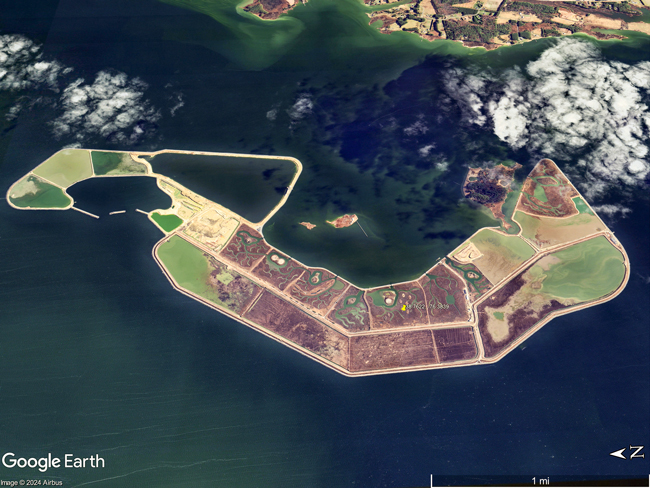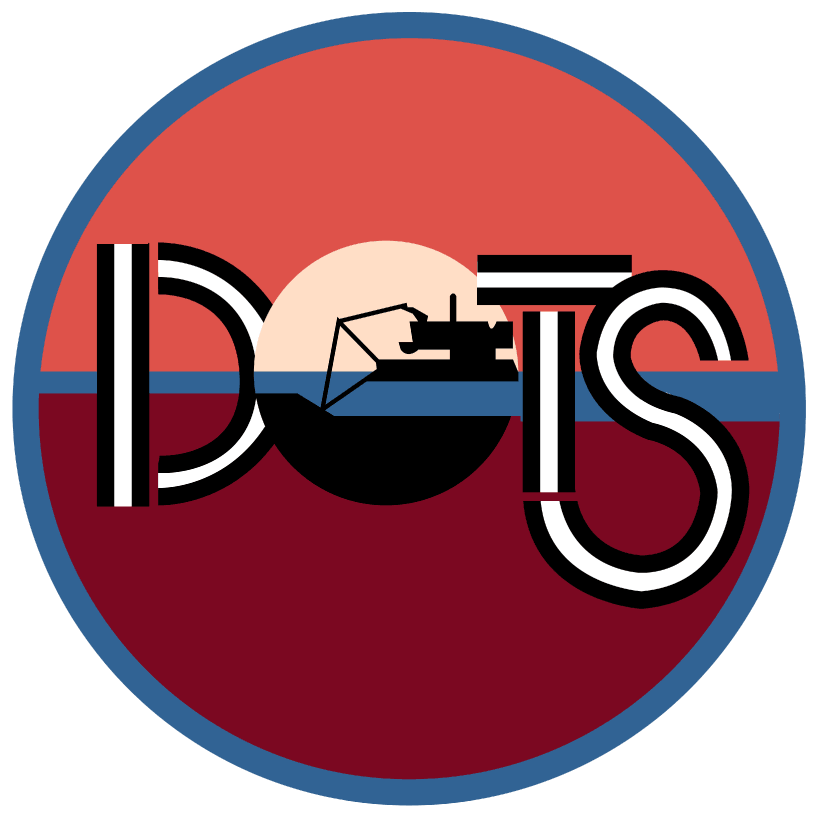Poplar Island

- Title: Poplar Island
- State: Maryland
- Project type: USACE
- Greater Beneficial Use Area: Chesapeake Bay
- Focus Area approximate center coordinates: 38.7622, -76.3839
- Nearest Federal Navigation Project: Baltimore Harbor
- Owner: USACE Baltimore District
- Beneficial Use Categories: Island Habitats, Wetland Habitats, Upland Habitats
- Dredge type: Hydraulic
- Status: Ongoing
- Keywords: Habitat Restoration, Poplar Island, Chesapeake Bay
Description:
Poplar Island is located off the Chesapeake Bay coastline, 34 miles southeast of the Port of Baltimore, Maryland. Land subsidence, rising sea levels, and wave action caused the disappearance of valuable island habitats throughout Chesapeake Bay – the nation’s largest estuary. In the 1800s, Poplar Island was over 1,100 acres in size and supported diverse habitats. However, by the 1990s, the island had eroded into four separate islands totaling just five acres.
Poplar Island was identified by the US Fish and Wildlife Service as valuable habitat for avian species such as eagles, osprey, and heron, and it was historically known to support diamondback terrapins and river otters, among other fish and wildlife. Islands are preferentially selected by many migratory birds and wildlife species for nesting, rearing, and feeding. Fish also use island boundaries for shelter and spawning.
In 1994, a multi-disciplinary team of stakeholders, including USACE Baltimore District, began developing a plan with Maryland Department of Transportation Maryland Port Administration to find a long-term management solution for clean sediment routinely dredged to maintain Port of Baltimore navigation channels. A disruption in dredging maintenance would have significant adverse impacts to the local and national economy, as it contributes approximately $2 billion in business to Maryland.
After evaluating the various alternatives, restoring Poplar Island was found to be the most viable and environmentally beneficial way to manage the sediment dredged by the Port. By 1997, construction and funding were approved, and from 1998 to 2001, six miles of containment cells made of sand, rock, and stone were constructed around the island’s remaining marshy knolls and tidal mudflats. These cells essentially created a 1,140-acre frame for the placement of 41.8 MCY of dredged sediment, which after grading and planting were designed to create a combination of upland, wetland, near-shore, and shoal habitats, offering a critical habitat diversity for local fish and wildlife.
Since 2001, clean sediment dredged during regular maintenance of the Port’s approach channels has been hydraulically pumped into the placement cells at Poplar Island at an average rate of 2 million cubic yards (MCY) per year (except no placement in fiscal years 2010-2011). Monitoring from as early as 2001 indicated that ospreys, egrets, terns, herons, eagles, turtles, and other wildlife were using the restored island.
Due to the initial success of the restoration, Congress authorized an expansion of the project in 2007 to accommodate placement of an additional 1.2 MCY per year of clean sediment dredged from other approach channels in the bay. From 2017 to 2021, the project team constructed four new wetland containment cells and one upland containment cell on the north side of Poplar Island. These cells framed 575 acres of land, and are projected to accept an additional 26 MCY of dredged sediment through 2031, bringing the total amount of sediment placed at Poplar Island to 67.8 MCY.
When all habitat development and adaptive monitoring are complete by around 2041, Poplar Island will consist of approximately 1,715 acres of total habitat: 776 acres of tidal wetlands, comprising low marsh and high marsh habitat, bird nesting islands, open water ponds, an upland portion spanning approximately 829 acres, and a 110 acre open water embayment.
Surveys through 2023 indicate over 250 bird species have been using Poplar Island, including 38 nesting species, and roughly 1,400 diamondback terrapins hatch at the island per year, making the restoration a resounding success. Poplar Island, once on the verge of disappearing, is today a national model for habitat restoration and long-term beneficial use of dredged sediment, helping to ensure the ecological and economic vitality of the Chesapeake Bay region.
Further readings:
- Bare B. (2023). Paul S. Sarbanes Ecosystem Restoration Project at Poplar Island Annual Update: January-December 2023. Keller S, editor. USACE Baltimore District.
- Roosenburg WM, Tokash AF, Ernsberger M. (2015). Terrapin Monitoring at the Paul S. Sarbanes Ecosystem Restoration Project at Poplar Island. Ohio University.
- USACE Baltimore District. (2005). Poplar Island Environmental Restoration Project, Chesapeake Bay, Talbot County Maryland: General Reevaluation Report (GRR) and Supplemental Environmental Impact Statement (SEIS). September.
- USACE Baltimore District. (2013). Paul S. Sarbanes Ecosystem Restoration Project at Poplar Island, Talbot County, Maryland: Limited Reevaluation Report. September.
- USACE Baltimore District. (2016). Poplar Island.
- USACE Baltimore District. (2023). Paul S. Sarbanes Ecosystem Restoration Project at Poplar Island, Talbot County, MD. February 1.
- USACE Baltimore District, MDOT MPA. (1996). Poplar Island Restoration Study, Maryland: Integrated Feasibility Report and Environmental Impact Statement. February.
Website links:
- US Fish and Wildlife Service. (2023). Poplar Island Restoration.
- USACE, Maryland Department of Transportation Maryland Port Administration, Maryland Environmental Service. (2024). Poplar Island.
Videos:
Poplar Island Expansion From Above. YouTube, Uploaded by USACE Baltimore 17 July 2017.
Poplar Island Flyover. YouTube, Uploaded by Helen Delich Bentley Port of Baltimore 16 August 2018.
Restored Poplar Island Saves Wildlife Habitat From Climate Change. YouTube, Uploaded by WBAL-TV 11 Baltimore 2 May 2022.
News Releases:
- Cox J. (2024). First Baby Eagles Hatch on Reborn Chesapeake Island. Chesapeake Bay Journal. June 3.
- Nappi R. (2019). Twenty-Five Years of Work at Poplar Island Brings Improved Habitat, Expanded Use of Dredged Material. U.S. Army. July 26.
- USACE. (2021). Poplar Island Ecosystem Restoration Expansion Complete, Open to Accept Dredge Material. January 28.

